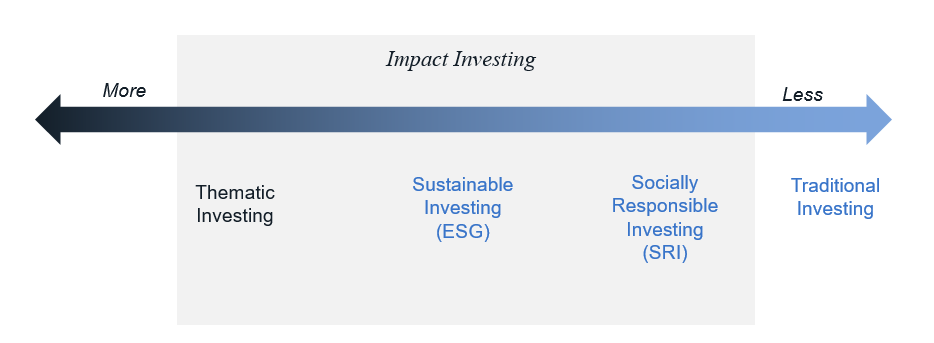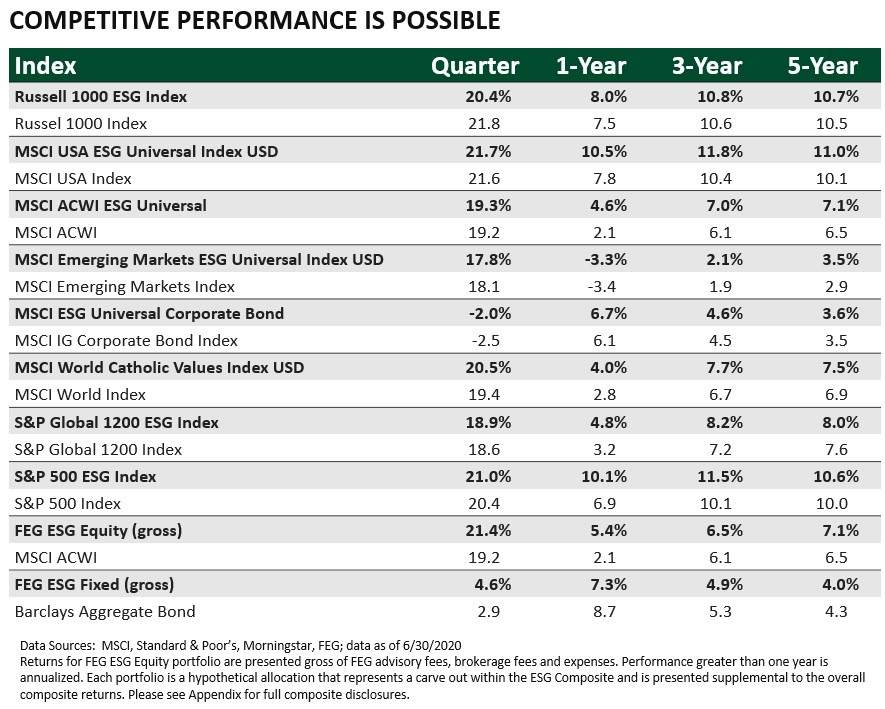The New Frontier: Impact Investing Explained
Impact investing, sometimes called socially responsible investing, is becoming increasingly popular among investors. According to the Forum for Sustainable and Responsible Investment’s 2020 Trends Report, between 2018 and 2020, the total number of U.S. sustainably invested assets under management grew 42% (from $12 trillion to $17.1 trillion). For context, the $17.1 trillion represents 33% of $51.4 trillion in total U.S. assets under professional management at year end 2019. Furthermore, many statistics support the notion that impact investing is still in the infant stages and it will only become an even bigger investment trend than what it is today. For example, a 2019 Morgan Stanley Survey found that 90% of millennials desire to customize their investments to their values. With $30 trillion of wealth being transferred from baby boomers to millennials over the next few decades, impact investing is expected to become an increasingly important part of the investing landscape.
What are the different types of impact investing?
The impact investment approach that an investor adopts depends on their level of intentionality. This can range from exclusionary screens to targeted thematic impact investments. Every investor will have different approaches, goals, and values when it comes to impact investing, therefore, deciding on how to best incorporate these customized objectives into an investment portfolio will depend on several factors. When it comes to developing an impact investing strategy, it is important for investors to understand the differences among Social Responsible Investing (SRI), Environmental, Social and Corporate Governance (ESG), and Thematic Impact Investing.

Socially Responsible Investing (SRI)
Socially responsible investments integrate social and environmental factors in investment analysis; this often includes negative exclusionary criteria that conflicts with an investor’s values. An SRI investment can address just one issue (i.e. the exclusion of companies associated with fossil fuel), or it can address multiple issues (i.e. avoid sin stocks, companies associated with animal testing, weapons manufacturing, etc.). SRI is most commonly used in public markets and is easily accessed by all investors. Investors can include different SRI factors into their investment strategies through tailored ETFs and mutual funds that invest through an exclusionary lens.
Environmental, Social, and Governance (ESG) Investing
ESG investing is an inclusionary investing approach. ESG factors are a quantitative and qualitative subset of non-financial performance indicators, which include sustainable, ethical, and corporate governance issues. Ultimately, it focuses on companies making an active effort to either limit their negative ESG impacts or deliver positive ESG impacts (i.e. a technology company that utilizes renewable energy-powered data centers). Public market investment vehicles (ETFs and mutual funds) incorporating an ESG framework are becoming more readily available, in addition to private market vehicles. Most publicly traded investment options include an all-encompassing ESG inclusionary option. However, separately managed accounts (SMAs) and private market strategies (i.e. private equity, private real assets) can hone in on more customized options (i.e. sole focus on environmental change or a certain social aspect).
Thematic Impact Investing
Thematic impact investing is made with the intention to generate positive, measurable, social and environmental impact alongside a financial return. The thematic impact investment market aims to provide capital to address some of the world’s biggest challenges, such as renewable energy, affordable housing/healthcare, gender/diversity equality, and education to underserved communities. Thematic impact investment themes exist in nearly all asset classes, sectors, geographies, and regions with various ranges of expected returns. They can range from lower-risk/lower reward opportunities, like local loan guarantees or microfinance, to higher-risk/reward opportunities like venture capital. Many private investment funds exist to correct a specific global issue (i.e. a private equity fund that invests in companies with diverse leadership). There continues to be an increasing amount of options in this space in regards to specific themes. Therefore, investors have a plethora of investment options to select certain strategies that align with how they want to impact the world.
How do impact investments perform?
Impact investors are bound to have diverse financial return expectations. Some investors are willing to accept below-market-rate returns as long as the social or environment impact is in line with their values. For instance, grant support sacrifices all financial return for the purpose of advancing the grant makers specific missions and addressing a distinct set of needs important to them. For example, a grant can be used to fund start-up costs of an investment fund intended to support the growth of high-quality education in Africa. On the other side of the spectrum, some investors are not willing to make a sacrifice when it comes to their financial return. For example, impact private equity vehicles exist to provide financial returns and have a positive impact on certain issues (i.e. diverse led venture capital funds that solely invest in diverse led businesses).
 Source: Global Impact Investing Network (GIIN)
Source: Global Impact Investing Network (GIIN)
By and large, impact investing has grown enough in popularity that investors are able to find opportunities that align with both their values and return expectations. For example, global ESG indices provided competitive returns versus their non-ESG counterparts when looking at the past 3 and 5 year performance numbers for the period ending 6/30/20. This can be partially attributed to the exclusion of the energy sector (see table below for more information).
 Source: FEG Investment Advisors
Source: FEG Investment Advisors
Closing Thoughts
The days of investment pundits believing that profits and positive social and environmental impacts were mutually exclusive have ended. As noted earlier, impact investing is in the midst of a metaphorical “gold-rush” with no signs of stopping. Impact investing offers the option to have the best of both worlds. Investors are able to combine the goals of doing good and doing well.
If you would like to learn more ways on how to align your individual values with your investment portfolio, please don’t hesitate to reach out and speak with one of our experienced advisors.


